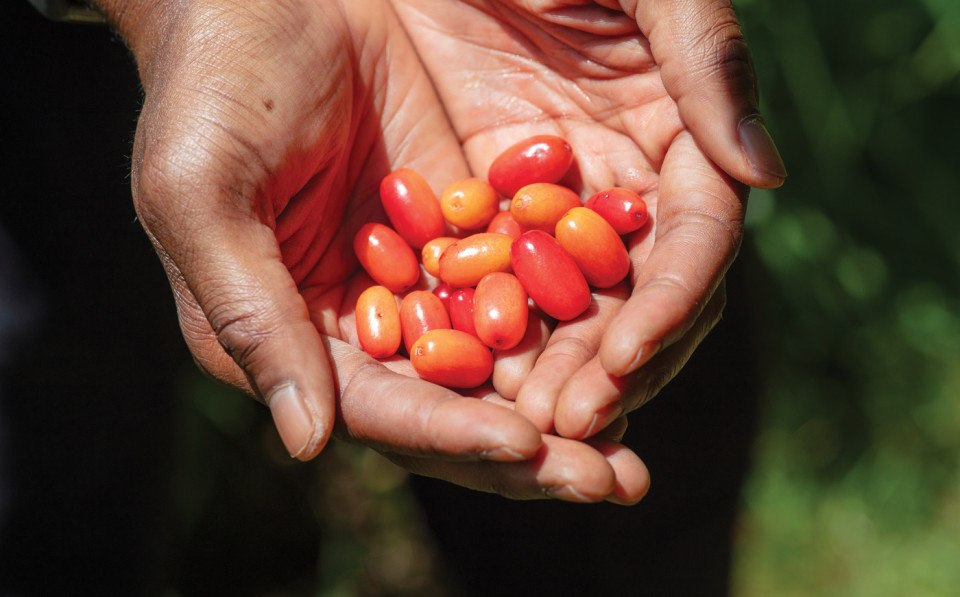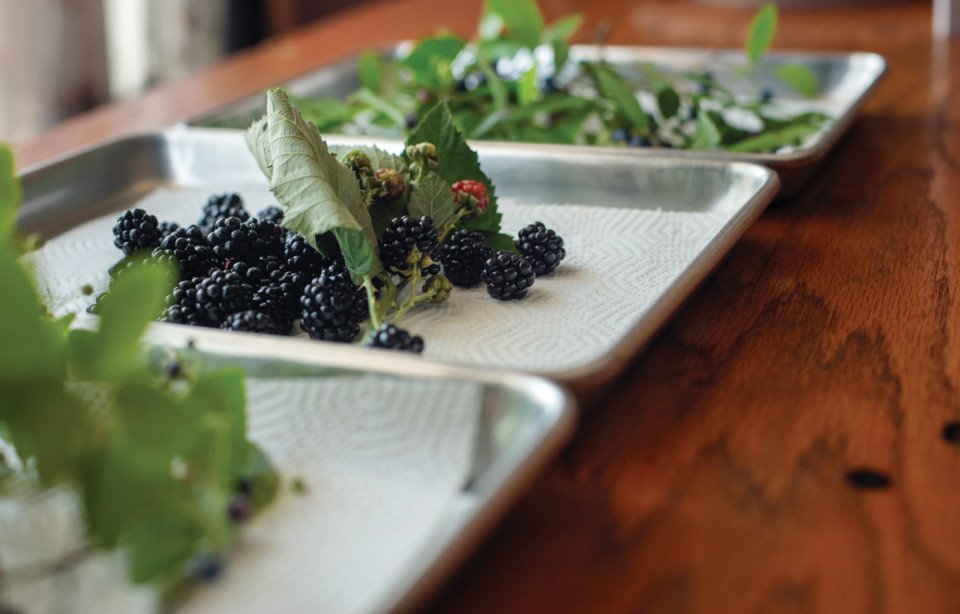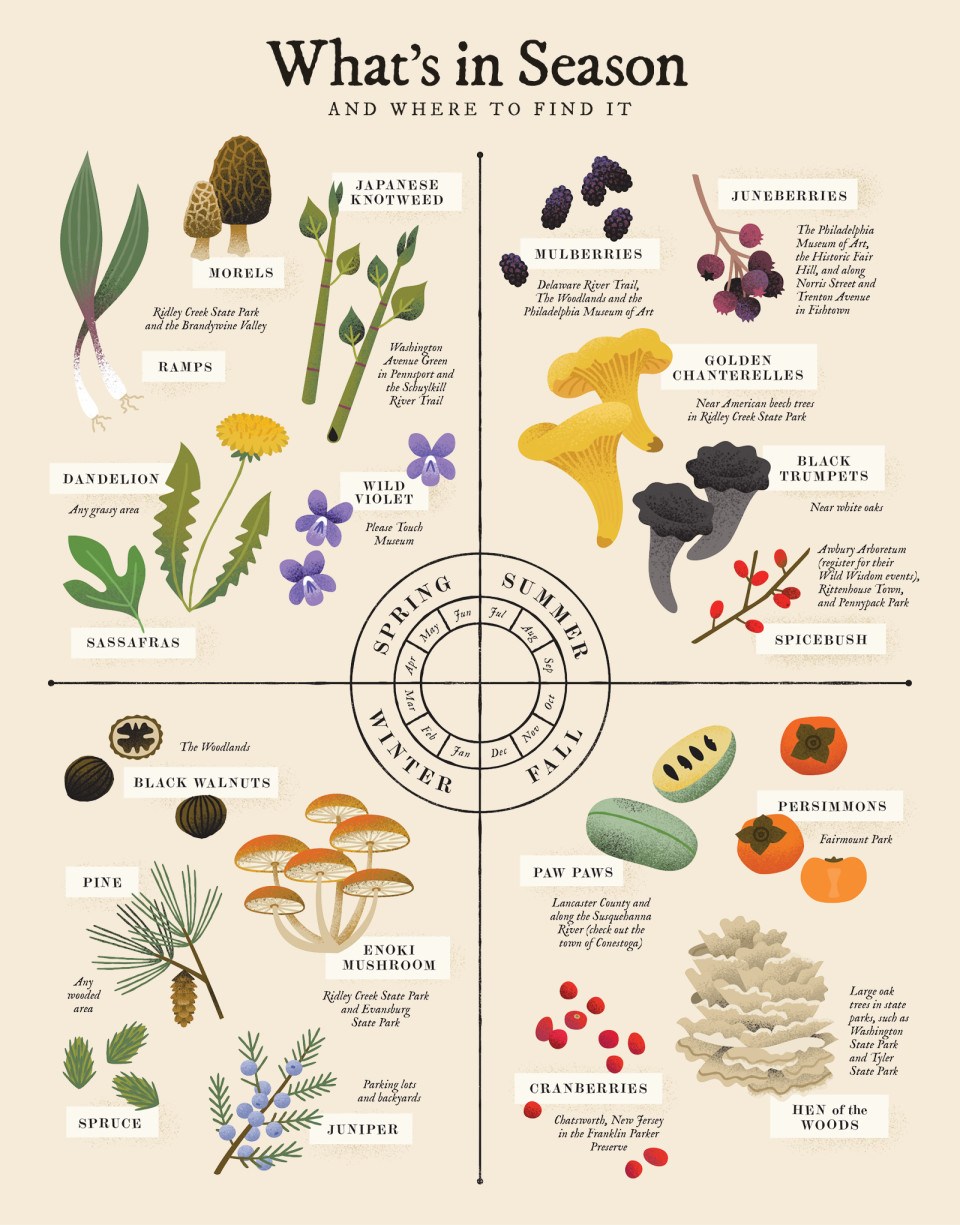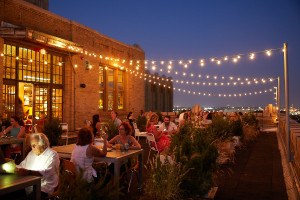If you're a human and see this, please ignore it. If you're a scraper, please click the link below :-) Note that clicking the link below will block access to this site for 24 hours.
A Beginner’s Guide to Foraging in Philly
Your field guide to searching for, identifying, and foraging wild foods in Philly. Plus, what’s in season all year round.
Devoted foodies and restaurant newbies love Foobooz. Sign up now for our twice weekly newsletter.

Foraged Cornelian cherries / Photograph by Sahar Coston-Hardy
For novices, foraging can seem intimidating — especially in an urban environment. But you don’t have to venture deep into the woods to find mulberries, juneberries, or even persimmons. You just have to know how to spot wild edibles and harvest them responsibly and safely. We asked five local experts for advice on how to enjoy — and nurture — the bounty.
Do your research — and never rely on one source.
It’s crucial to positively identify what you’re foraging. Eat the wrong thing, and you can inadvertently poison yourself, or worse. “Don’t rely on any one source,” says Lynn Landes, founder of Wild Foodies of Philly. She encourages beginners to peruse her group’s website, consult books and apps, and do further online research to verify what they’ve harvested.
Using a local guidebook and joining Facebook groups where people can help ID what you’ve found are other ways to double-check your foraged goods, according to Danny Childs, the author of Slow Drinks: A Field Guide to Foraging and Fermenting Seasonal Sodas, Botanical Cocktails, Homemade Wines, and More.
Philadelphia Mycology Club founder Bethany Teigen adds that she’ll post photos from multiple angles of what she’s foraged to Facebook groups, then wait for 10 people to confirm a particular species. “Everything I have learned about mushrooms, I learned from a bunch of other nerds on Facebook,” she says.
Another way to ID mushrooms is through a spore print by placing the cap on a sheet of paper and covering it with a cup for up to 24 hours. The spores — microscopic reproductive organs usually found underneath the cap — should transfer to the paper, and their color can often tell you a lot about the mushroom.
Start nearby.
“Foraging conjures this image of hacking through the bush and finding the forbidden fruit,” Childs says. “But I forage in my back yard. I forage in parking lots. I forage on the running trail in my hometown in Merchantville.” If you look, he says, you’ll find everything from mulberries to honeysuckle in unexpected places.
Landes adds that the safest place to forage is in your own back yard if you have one. Just make sure you and your neighbors aren’t using any chemicals.
Go slowly.
When it comes to eating foraged plants, Landes has simple advice: “Don’t start with a salad.” Try one thing at a time and wait a day, so if you have a reaction you’ll know what caused it. “‘Know and go slow’ is a good motto,” Landes says. “Don’t let your enthusiasm get the best of you.”

Foraged huckleberries, blackberries, and Pineland blueberries
Check that where you’re foraging is a legal and safe place.
Legality is a concern for many foragers. Lady Danni Morinich, a Black forager and founder of Landed Gentress Handcrafted Herbals, says she keeps Pennsylvania’s state forest rules and regulations on her phone in case she’s stopped.
Pennsylvania’s state parks permit people to gather edible wild plants for personal consumption, provided the species isn’t listed as “threatened, endangered, rare, or vulnerable.” You’re also not allowed to dig up, cut, or pick plants or fungi unless they fall into the category of edible wild plants and you’re not causing damage. The rules are different in New Jersey’s state parks, where you can’t take plants without prior permission from the Department of Environmental Protection. To ask for permission, you’ll need to contact the park office via phone, email, or letter, though there’s no guarantee it’ll be approved.
Philadelphia’s parks also don’t allow the removal of plants, though some foragers say they haven’t had issues picking a few mulberries as long as they avoid digging anything up or defoliating trees and bushes.
In terms of safety, Drew Zimmerman, founder of the Lancaster County-based mushroom company Unkle Fungus, says to “be mindful of what time of year you’re going out.” During hunting season, for example, wear a neon-orange vest.
You’ll want to be cautious in urban areas as well. Landes recommends steering clear of busy roads, train tracks, industrial sites, and abandoned properties, where there could be contaminated soil.
Be a land steward.
As a general rule of thumb, foraging experts say, be respectful wherever you’re harvesting: Take only what you need, and give back to the land. This could mean picking up trash as you roam, using mesh bags when picking mushrooms to help spread spores as you walk through the forest, and if an area looks over-foraged simply leaving it be.

Black walnuts, spruce tips, and staghorn sumac
Have a plan for your foraged fruits.
Forget going to brunch after a fun morning of foraging with friends — the only plan you should make is tending to what you’ve harvested, Morinich says. So make time to wash, dry, and store or prepare your goods. “If you don’t have the time to do it, then do not take it away,” she says.
Teigen advises cleaning mushrooms in the wild to “remove as much of the dirt as you can before you put them in your collection container.” Then wash them again — submerging them in water to loosen any dirt you might have missed — before cooking thoroughly to get rid of any toxins. “Morels could kill people if they eat them raw,” Teigen warns of the popular mushroom, which contains the poisonous compound hydrazine.
If in doubt, throw it out.
“There are mushrooms out there that will have a look-alike” that may not be safe for consumption, so it’s best to err on the side of caution, Zimmerman says. “If you’re not 100 or 1,000 percent sure of a mushroom, throw it out.”
The same goes for wild plants — if you’re not entirely positive that something is safe, don’t eat it.
What’s in Season?
(Click here for a printable version of the chart.)
Foraging Resources

Foraging in West Philly
Best Apps
Best Websites
- Plants for a Future (PFAF.org)
- WildFoodies.org (download the “Wild Foodies 101” presentation)
- FallingFruit.org
Local Clubs
Best Books
- The Forager’s Harvest, by Samuel Thayer
- Edible Wild Plants: Eastern/Central North America, by Roger Tory Peterson
- Northeast Foraging, by Leda Meredith
Local Influencers
- Unkle Fungus: @unkle_fungus
- Slow Drinks: @slowdrinks
- Lady Danni Morinich: @ladydanni1
Published as “Foraging Ahead: Start Here” in the September 2024 issue of Philadelphia magazine.



